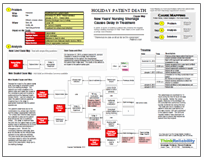In May 2010, a living liver donor died on the operating table. Investigation showed that there were multiple issues related to the patient’s death. The clinic was cleared of any wrongdoing in the death – and the surgeons there don’t believe that the surgical issues contributed to the death – but the clinic was cited for violating rules designed to inform and protect donors.
We can look at all the related issues and see the cause-and-effect relationships in a Cause Map, or visual root cause analysis. We begin with the impacts to the goals. The patient death is an impact to the patient safety goal. Patient deaths also cause impacts to related employees, which is an impact to the goals. The citation for the violation of donor protection rules can be considered an impact to the compliance goals. As a result of this incident, the clinic voluntarily stopped operations on living donors for 4 months, which can be considered impacts to the schedule and customer service goals. Once the impacts to the goals are determined, we can begin with an impact and ask “why” questions to add detail to the Cause Map.
 The patient death was determined to be due to a combination of cardiac arrest and excessive bleeding. The cardiac arrest occurred because the patient’s heart was too weak to withstand surgery, and the patient was undergoing surgery. The patient was donating a portion of his liver as a “living donor”. Because the patient was not properly informed prior to his surgery, it’s unclear whether he would have continued if proper processes had been followed. Donors are required to be given outcomes from both the site performing the surgery and national results. The information the donor received was not up-to-date, as the paperwork had not been updated. Additionally, because the donor’s needs may be opposite of the recipient’s needs, the donor’s advocate is required to be involved only in the donor’s care. In this case, the advocate was also involved in the recipient’s care. Lastly, the patient received an abnormal EKG (which indicated that he may have had a prior heart attack) during his operation prep. Although later testing showed that there was no reduction in blood flow to the heart, it’s unclear whether the patient was aware of these results or in a cardiologist was consulted. The patient did not request a second opinion to determine whether or not he was healthy enough to handle the surgery.
The patient death was determined to be due to a combination of cardiac arrest and excessive bleeding. The cardiac arrest occurred because the patient’s heart was too weak to withstand surgery, and the patient was undergoing surgery. The patient was donating a portion of his liver as a “living donor”. Because the patient was not properly informed prior to his surgery, it’s unclear whether he would have continued if proper processes had been followed. Donors are required to be given outcomes from both the site performing the surgery and national results. The information the donor received was not up-to-date, as the paperwork had not been updated. Additionally, because the donor’s needs may be opposite of the recipient’s needs, the donor’s advocate is required to be involved only in the donor’s care. In this case, the advocate was also involved in the recipient’s care. Lastly, the patient received an abnormal EKG (which indicated that he may have had a prior heart attack) during his operation prep. Although later testing showed that there was no reduction in blood flow to the heart, it’s unclear whether the patient was aware of these results or in a cardiologist was consulted. The patient did not request a second opinion to determine whether or not he was healthy enough to handle the surgery.
Excessive bleeding occurred during the surgery and was thought to also have contributed to the patient’s death. Bleeding occurred because the patient was in surgery. Because the type of surgery the patient was doing is relatively new, it’s also possible that the surgeon’s lack of familiarity with the surgery may have contributed to the bleeding. The bleeding wasn’t able to be stopped because it was difficult to find the multiple sources. The patient was having laparasopically assisted surgery, which results in a quicker recovery time for the patient but also means that the bleeding source needs to be found through small holes, rather than one large incision. Although the surgeons say it was not related to the patient death, a high speed blood pump was not used, though it was available, and the procedure for massive bleeding was not followed.
Whether or not these issues contributed directly to the patient’s death, they should still be reviewed as sources of improvement for the facility. Other facilities as well can use this incident to examiner their own procedures and look for opportunities to increase patient safety.
To view the Outline and Cause Map, please click “Download PDF” above.









